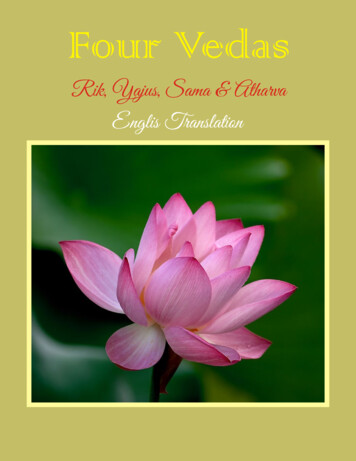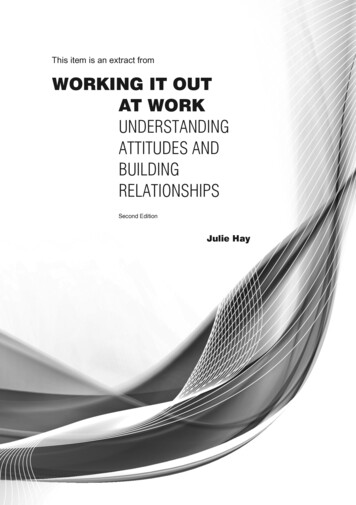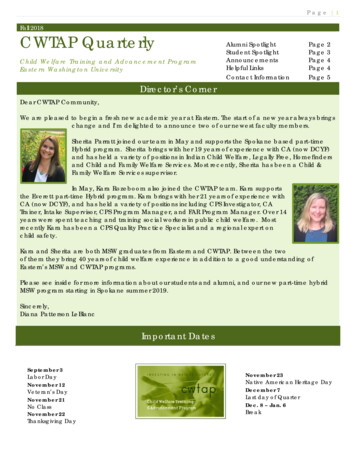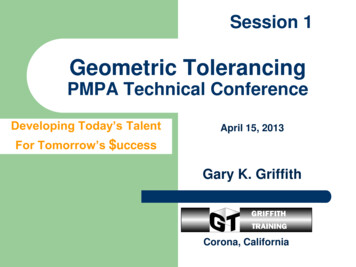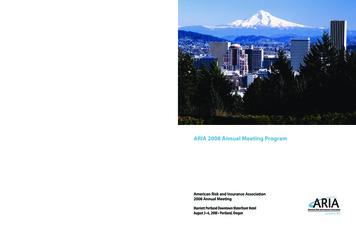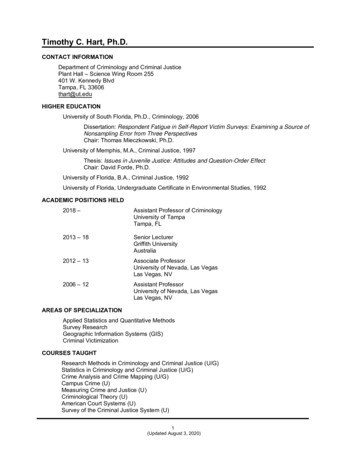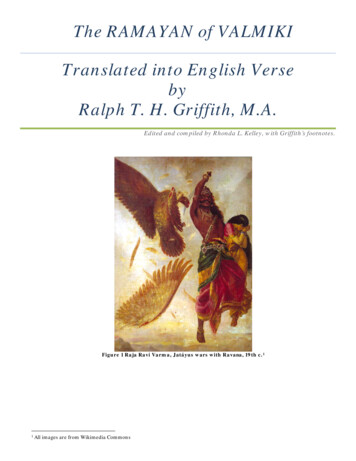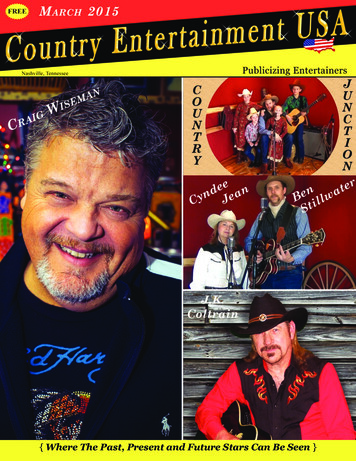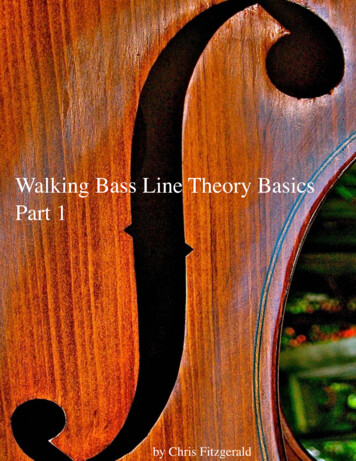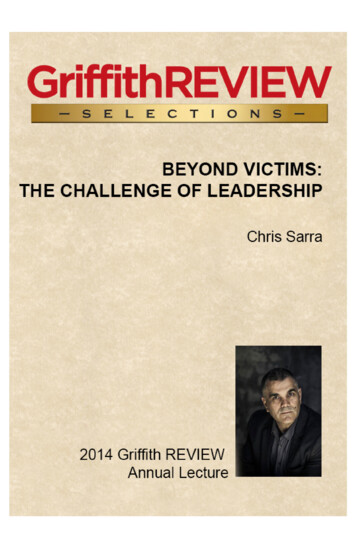
Transcription
Chris SarraDR CHRIS SARRA is the founder and Chairman of the Stronger SmarterInstitute. Chris grew up in Bundaberg in Queensland and is the youngest of ten children. He experienced firsthand many of the issues faced byIndigenous students throughout their schooling. Encouraged and supportedby some teachers and mentors, Chris successfully completed a Diploma ofTeaching, a Bachelor of Education and Master of Education and a PhD inPsychology with Murdoch University. His published thesis is titled Strongand Smart – Towards a Pedagogy for Emancipation Education for FirstPeoples and autobiography Good Morning, Mr Sarra.In the late 1990s Chris took on the challenges of Indigenous educationas Principal of Cherbourg State School in South East Queensland. UnderChris’ leadership the school became nationally acclaimed for its pursuit of theStronger Smarter philosophy, which significantly improved the educational,and life outcomes of its students.
GRIFFITH REVIEW ANNUAL LECTUREBeyond victimsThe challenge of leadershipLADIES AND GENTLEMEN, let me start as I should by acknowledgingthe traditional custodians of the land upon which we meet, the Turrbal nationof the north and Jagara nation of the south. I offer this acknowledgement, notin a piecemeal way, but rather in a serious way, in which I offer myself to thisforum in this place, with pure motives and an authentic need for strength andcourage, as I lay out my intention to challenge both white and AboriginalAustralia to understand and embrace a new style of leadership.It is past time.As an educator I am reasonably content with the part I have played inchanging expectations of Aboriginal children. I would not pretend for amoment that we are all the way there, but we are a very long way from wherewe were in education.That said, I watch with some dismay, Australia repeat a pattern which,for more than two hundred years, has probably delivered more failure andsorrow than success. This is not a black or white issue. This is an issue for allof us. And my sense is that if we can understand some of the fundamentalaspects of a ‘high expectations relationship’, then we truly can transcend thechallenges we face together.While many have warned me that there is a great deal of risk in sayingwhat I have to say tonight, even more yearn for things to be said. I know that
4 GriffithREVIEW44when one pulls back the curtain and says publicly what is often only spoken ofbehind closed doors, people get angry and defensive; particularly those whorecognise their own behaviours. While I accept that some get people will getangry, I hope even more will welcome the opportunity for frank discussionand to transcend the toxicity that stifles our relationship today.To my supporters and detractors alike I say this: Argue the merits of whatI say, but don’t twist my words. Don’t cherry pick details and quote them outof context or pretend that this very serious discussion can be reduced to justa few phrases.Being subject to public attacks is one of the costs of leadership, and, whileit is often hurtful on a personal level, this is not a reason to avoid leading whenit is required. Leadership means putting the needs of others, the greater goodif you like, ahead of your own comfort. It includes an obligation to call thingsas you see them; to put one’s beliefs out there to kick around; and, in so doing,offer some solutions.It has long been said that leadership is characterised by three traits:courage, compassion and commitment. Many leaders are courageous andwork hard, but often lack commitment to lead for all. Others have compassionand commitment to a cause, but not the courage to call out bad behaviour.History’s great leaders exhibit and balance all three traits.Tonight I trust you with frank insights from someone who is very muchan insider. Some might experience my truths as brutal. I have no wish towield words like weapons. I have made many tough calls across my career todate, but have always done my best to play the issue not the person. While mytruths may be brutal I have no interest in ‘pitchfork politics’.I also have no interest in playing to any particular constituency.Some of my great friends and supporters will disagree with some aspectsof what I have to say tonight. Disagreement is welcome and should bewelcome. We can often learn as much from those with contrary opinionsas those who share our view. Instead, so often, we have become a land ofoutrage. Beliefs which aren’t our own are shouted down and denounced,often by those with bruised or out-of-control egos. It might makesome of us feel good, but it does not help us reach sane, commonsensesolutions. Criticisms and constructive feedback offered with pure motivesare not reasons to get angry and abuse others; rather they are gifts to
Chris Sarra: Beyond victims 5reflect upon for the purpose of growing, evolving and being the bestthat we can be.Without frank discussion – the willingness to speak what we know andbelieve in our hearts – nothing will change. If honesty offers a chance for allof us to transcend the current challenges we face together, then clearly beinghonest is worth the risk. To be silent and to lack courage here is collusion withthe toxicity that contaminates our society.There is no pleasure for any of us as we reflect on the futility of thebillions spent to somehow ‘fix’ Aboriginal Australia. After all these decades,after billions spent to close the gap, after apologies and reconciliations, despitemost Australians wanting things to change, to realise we have got the veryfoundation of our relationship wrong. In order to ‘fix’ Aboriginal Australia,we have to ‘fix’ white Australia, at that foundation. This means fixing therelationship we share.My intention from here is not to entice you into a sense of despair, butrather a sense of hope. I’ve seen high expectation relationships in Australiaand they are something brilliant to behold.IN A DRAMATICALLY remote part of Australia on the APY Lands(Anangu Pitjantjatjara Yankunytjatjara), Hughie, an old Aboriginal man,sits at the foot of ancient hills on his country under a crisp yet brilliant bluewinter sky. His face is unshaven, his hair all dusty and his clothes somewhatdisheveled, but what is crystal clear and diamond bright in his eyes, is aprofound sense of love in his heart, and hope for the children around him.Around him the dust is shifting thanks to the active and ever shifting barefeet of more than a hundred Aboriginal children from the local school, Indulkana. The principal, Paula McGuire, has insisted that as part of their schoolprogram they must spend some time on country learning with local Elders.She scans the area with a confidence anchored in part by knowing that backin their school the children’s classrooms are just as intellectually rigorous,but in a different way, with walls adorned with rich Standard AustralianEnglish text in print alongside high-quality examples of student work. Theclassrooms at Indulkana School are as intellectually stimulating as any otherone might see in metropolitan or provincial parts of Australia.In many remote schools in Australia that is not the case. At Indulkana it is
6 GriffithREVIEW44clear there is no need to choose between strong in culture or smart in modernAustralian ways. Paula McGuire knows children can have both; she workstirelessly with her team and the community to ensure they are afforded thishuman right to be strong and to be smart.Back on country it’s hard to know exactly what is exciting the childrenmost at any particular point of the afternoon as they speak rapidly in theirown traditional Aboriginal language. Speckled amongst them are all of theschool’s white teachers, Aboriginal teachers and teacher aides, and a handfulof young white students up from Adelaide, all sharing in the sophisticatedknowledge and enchantment that surrounds them. The children meanderfrom one place where some old male Elders sit by a smoky fire and teach themhow to make spears, to the next where some old ladies sit cross-legged as theyhave done for generations and teach them how to weave. From here they canget painted up for the dances they will learn and perform later; they can learnhow to make a wiltcha, an ancient yet enduring and traditional form of shelter;they can explore and wander up onto the ancient hills that hug their camp,or they can just sit and yarn.‘Look at all these children!’ Hughie beckons with enthusiasm. ‘Look atthem all here happy and learning on my country! One minute they sittinghere listening to us old people and next minute they running all over thesehills having fun.’He pauses for a moment to bask in the euphoria of what is occurring allaround him.‘This makes me so happy!’ he beams as tears of pride and joy mingle inhis glinting, timeless eyes.Many might hear me proffer the term, ‘high expectations relationship’ and not really have a clue what I mean. Some might think of it assome nebulous, aspirational concept that is probably, at best, somewhere inthe distant future, or at worst, merely a pipe dream as our differences seempoles apart. The relationship between school and the community of Indulkana is manifestly a relationship with the First Peoples of Australia based onrespect and high expectations, and one where two diverse worlds are broughttogether.This is no pipe dream. This is the stronger, smarter, high expectationsrelationship I believe in. It is a relationship that offers tangible insights into
Chris Sarra: Beyond victims 7how Australia can transcend the challenges we face together as Aboriginaland white Australians to become a truly great nation with nothing to beashamed of.As a basis for this discussion let me start with the Stronger Smarterphilosophy which has been articulated, after much practice, in schools andcommunities and reflect on what are the key overarching philosophicalframework elements that guarantee success.The Stronger Smarter philosophy honours a positive sense of culturalidentity, and acknowledges and embraces positive community leadership,enabling innovative and dynamic approaches and processes that are anchoredby high expectations relationships. High expectations relationships honourthe humanity of others, and in so doing, acknowledge one’s strengths, capacity, and human right to emancipatory opportunity.Doing things WITH people, not TO them.While some might dismiss my intent here as either too romantic or tooambitious, let me assert that the knowledge and skill required here is relativelybasic. This is not to pretend for one moment that the path forward is easy. Inmy conversations with school principals and teachers, time and time againI’ve made it clear that we actually know what we need to know in order totranscend the challenges we face in Aboriginal education.The solutions are actually simple, yet the work is always very hard.We know money is not always the answer and evidence aboundshere. In some places its true that more money is required, while inother places resources are quite substantial. In every case though what isrequired before anything else is hard work – the kind of hard work thatrequires a high personal commitment and can sometimes come at a highpersonal cost.A part of what makes the work so hard is relinquishing long held, stiflingbeliefs and attitudes about Aboriginal students. Unless this is done, we cannothope to engage in new and more honourable ways of thinking and behaving in the relationships with those Aboriginal students and their parents.And unless we create these new relationships, the failure will continue. Itis almost as if many teachers and principals have to unlearn all they believeabout Aboriginal students, look past the black faces in classrooms and startto see students. When they start to see students, as curious as any, they can
8 GriffithREVIEW44make honourable choices about what education outcomes are good enough.Having re-established educational outcomes that are honourable and worthyof pursuit in any school, it then becomes worth remembering we are in arelationship with Aboriginal children here. At this point we must observeand be receptive to cultural complexities that enhance or stifle our pursuit ofthose more honourable outcomes.AGAIN, WHILE THE Stronger Smarter approach – a strength-basedapproach, intent on doing things with people not to them – might seemsomewhat exotic and erudite, it is this very approach which underpinned thehard work and resulted in the following results at Cherbourg State School:Unexplained absenteeism reduced by 94 per cent within 18 months;Real attendance improved from 62 per cent in 1999 to 94 percent in 2004 (without touching welfare payments);Year 7 diagnostic reading tests went from 0 per cent at stateaverage in 1998 to 81 per cent (n 17) at state average in 2004;58 per cent improvement in Year 2 literacy within two years;andFive local Aboriginal teacher aides completed teacher trainingwhile studying and continuing to work at the school.Evidence shows this type of success has been replicated in numerousother schools and communities that have embraced the Stronger Smarterapproach and it is my belief that this view can be extrapolated to reflect onthe broader societal relationship between Aboriginal and white Australia. It isworth restating to those interested in the pursuit of excellence for Aboriginalchildren and communities: the solutions are simple, yet the work will alwaysbe hard.THE FIRST PILLAR of the Stronger Smarter philosophy compels us to cometo grips with our beliefs about ‘ a positive sense of cultural identity’. Thiscannot be done without first flushing out the dynamics of our relationship and,more specifically, those contained within the dominant conceptual binary of‘mainstream’ and ‘other’. Put simply, there is mainstream Australia and there is
Chris Sarra: Beyond victims 9the rest, with dramatic undertones suggesting it would be best if we just look,behave and speak like those in the mainstream. The notion of ‘othering’ is notnew to intellectual discourse and I have discussed this in greater detail in earlierworks. For the purpose of this paper it is useful to revisit some of this conversation given the intense and persisting subscription to the notion that the onlyway forward for Aboriginal Australia is to become ‘mainstream’, whereby thatsense of being mainstream means surrendering being Aboriginal and, further,acquiescing to the notion that being Aboriginal means being inferior.For the purposes of my PhD research I conducted thirty forums,involving more than two hundred people, at which I asked participants tooffer adjectives or words to articulate mainstream Australian perceptions ofAboriginal people. I was always cautious to point out at each forum that I wasnot after their ‘personal perceptions’ but rather, how they thought mainstreamAustralians would describe Aboriginal people. Below is a list of the words andphrases that were presented at every forum:Alcoholics, DrunksBoongs, Coons, Niggers, Black Bastards, Gins, DarkiesGot it Good, Well-kept by government, PrivilegedWelfare dependent, Dole bludgers, Handout SyndromeLazy, Won’t workAggressive, Violent, Troublemakers, DisrespectfulIt’s always shocking to reflect on such research and it is a reflection Idon’t particularly enjoy. I’d like to imagine that if I conducted similar researchtoday I might get quite a different response. Some might wonder why thereis nothing positive listed here. On many occasions there were positive references to Aboriginal people as being artistic, family oriented, sporty, but forthe purpose of this discussion I will focus on those words presented on everyoccasion.Clearly this is not an accurate reflection upon who we truly are. Anyonewho imagines it is some kind of accurate reflection of us should really questiontheir ability to connect with the humanity of others. This isn’t to deny that wehave elements of these traits and behaviours in our communities, as all communities do, but it is to affirm that those descriptors are not part of ‘Aboriginal’cultural identity. These are stereotypes that have been cast upon us historically.
10 GriffithREVIEW44Confronted with this phenomenon it becomes imperative that we observe andunderstand the source of such toxic perceptions, given their ability to influencebehaviour and somehow manifestly emerge as some form of reality for some.As unpalatable as it might seem there is no escaping that the greater source ofsuch toxic perceptions is indeed white Australia.This is not to lay the blame for the current state of Aboriginal Australiaentirely at the feet of white Australia, but it does take us to one of the centraland most crucial points of this entire paper: Aboriginal Australia must notbe dominated by mainstream Australia’s perception of who we are. We, asAboriginal people, must be able to reject absolutely the negative stereotypeof being Aboriginal that we have been consistently bombarded with. Onlythen can we understand, assert and define who we are based on our terms,by the truth of our strengths: our courage, our dignity, humour in the faceof despair, our broad sense of family, and our sense of spirituality and ancientconnections to country.While false stereotypes exist, their dynamic presence has a dramaticeffect. It typecasts an entire group of Australians as people to be feared ordespised – in academic theory they become the ‘feared/despised other’. Suchdishonorable posturing undermines not just the humanity of AboriginalAustralians; it ultimately undermines the humanity of all Australians.It is against this background that tolerating poor conditions in someAboriginal communities becomes explainable. Put simply, if it is only hopelessand despicable Aborigines then why should we bother trying to make a difference to their wellbeing and functionality of their communities? If it is onlydespised Aborigines then what is the big deal if a police officer is found to‘cause the death’ of one of them? If it is only Aboriginal communities thenwhy bother injecting quality teachers and health workers, when we caneventually just blame the community for such appalling dysfunction?The casting of Aboriginal Australians as a hopeless, feared or despisedother, has enabled such disobliging cycles of chronic neglect and draconianintervention. Intervention in terms of dispossession and alienation fromland, neglect in terms of leaving people to die; intervention in terms ofAssimilation policies, neglect in terms of provision of adequate infrastructure and quality service provision. More recently, in this disobliging cycle Ispeak of, casting Indigenous Australians as hopeless and despicable enables
Chris Sarra: Beyond victims 11the Northern Territory intervention in which it is assumed that people areso hopeless that we had to send in the army to ‘fix’ them and we must,paradoxically, ‘empower’ people to spend money appropriately by quarantining their income. Time will tell whether or not we will indeed transcendbeyond this cycle together.As a way of transcending this cycle and the toxic dynamics they manifest,let me offer an intellectual concept devised by friend and philosopher RoyBhaskar of the London Institute of Education, which offers some deep insightsthat enable us to better contemplate a more harmonious Australia. Bhaskardiscusses the concept of the Concrete Universal, which has four dimensions.At its base is the notion of a core universal human nature:. we are all of thehuman race and this should ensure unquestionable grounds for human rights.At a higher level this basic core is acted upon, or mediated through,a variety of ‘differentiae’ such as gender, sexuality, age and ethnicity. Thecore and the mediations result in a ‘concretely singularised individual’. Thefourth dimension to this concept is that of ‘processuality’, or the rhythms oftime in action. The key to understanding the importance of the concept ofthe Concrete Universal is that it is part of a stratified ontology, or stratifiedinsight into our sense of being. Put simply, each of us has layers or stratifications of being. The notion of ‘processuality’ also allows one to recognise atdiffering times in the life of the individual, the mediations or the individualityor the core humaneness can be of greater or less salience. If we can accept theterms of Bhaskar’s insights then we have hope of being liberated from thosetoxic dynamics that are quintessential to the binary of mainstream/other,whereby the mainstream is somehow superior. Put simply, all of us are setfree from the pressures of being one or the other, as it becomes the case thatwe can be content with who we actually are, knowing that at some times weactually can have strong resonance with a sense of being mainstream and atother times, in other contexts, we can have equally as strong resonance witha sense of being other.By way of a quick and easy example, during the football season, I cheerloudest during round matches for the Cowboys, who are my NRL team. Icheer for Queensland during State of Origin matches, and cheer for Australiawhen they play tests against New Zealand or England. For those who arenon-devotees to the greatest game of all, let me offer something deeper, more
12 GriffithREVIEW44personal, and hopefully more insightful.When I stand on the land of my father’s people, my people, at the villageof Miglianico in the province of Abruzzo, Italy, my sense of being Italianresonates strongly for me. When I stand before the graves of my father’sparents, speaking Italian with my half-brother, Gulio, my sense of beingItalian continues to resonate strongly and he embraces me as such. At my coreI am human and the resonance of my Italian ethnic differentiae is dramaticallyenhanced by processuality which sees me in my father’s country, Italy, in thatmoment in time. Significantly, my sense of being Aboriginal or Australian isnot relinquished here; it simply does not resonate so strongly.When I am at home fishing in the Burnett River in Bundaberg, knowingmy people have done this for many thousands of years, my sense of beingAboriginal is very strong. In this place, in this point in time, I often lookacross the river to Paddy’s Island, a place where many of my ancestors wheremassacred and wonder what life must have been like for them before, duringand after the slaughter of so many. At my core here I am human and my senseof being Aboriginal resonates very strongly, enhanced by the sense of timeand place that locates me here. I have not relinquished my sense of beingItalian or my sense of being Australian.As I reflect on times when my sense of being Australian resonates morestrongly I think of Rugby League, of barbeques and the beach. In a deepersense I think of when my mum’s house in Bundaberg was completely floodedby the devastating January 2013 floods and a ‘mud army’ of volunteers who Ididn’t even know turned up to help my family clean and rebuild. At my corehere I remain human and as before my humanity is shared with those aroundme. My sense of being Australian resonates strongly here, given the time,place and context. In such times, when tragedy strikes, we stick together asAustralians and we just get in and help. It’s what we do. In this circumstanceI have not surrendered my sense of being Aboriginal or my sense of beingItalian.You may be interested to know that neither the Australian flag nor thenational anthem enhance my sense of being Australian. While I accept it maydo so for others, the Australian flag simply invokes thoughts of the shameful Cronulla riots and offensive bumper stickers that say things like, ‘Fuckoff, we’re full’. I suspect the Australian flag would enable my sense of being
Chris Sarra: Beyond victims 13Australian to resonate more strongly for me and for many others, if it was freeof the Union Jack. If our national anthem was like that of the New Zealand/Aotearoa and embraced an Indigenous language verse, then I’d be much moreproud to sing along and let my sense of being Australian hum. The prospectof changing the flag or the national anthem is ambitious at best, but let mesuggest this as a means by which we can contemplate ways to let our sense ofbeing Australian resonate more strongly together, while accepting, embracingand celebrating the sense of ‘otherness’ that indeed we all share.Understanding and embracing the notion of a stratified ontology notonly liberates Aboriginal people from the toxic dynamics of being forcedto be mainstream, it is indeed an intellectual concept that is emancipatoryfor white Australians. Many white Australians have experienced this also,perhaps unknowingly. Many have experienced a strong and very powerfulsense of ‘spirituality’ when visiting the graves of their ancestors in England,Scotland or Ireland for instance. At their core they remain human, whilethe differentiae of their ancestral ethnicity, enhanced by the processuality oftheir time and place, are the very dynamics that ‘fill a hole inside them’ asthey sometimes describe. Importantly they have not surrendered their senseof being Australian, but their sense of humanity is enhanced.THE SECOND PILLAR, if you like, of the Stronger Smarter philoso-phy signals the need to embrace Aboriginal leadership. Again this is not sostraightforward. In my own assessments of Aboriginal leadership over timeone can observe three categories of leadership: those who focus on being thevictim; those who focus on booting the victim; and those who focus beyondvictim status, or what I would call ‘stronger smarter leadership’.Before I go on, let me first challenge an unspoken convention amongstAboriginal Australians. The convention I speak of here is one in which weare encouraged to refrain from practices of ‘lateral violence’ and do not attackeach other publicly. I am deeply committed to upholding the essence of thisconvention and as such I am not out to make any personal attacks here. I am,however, deeply committed to challenging ways of thinking and behavingthat I consider unhelpful and contrary to the conduct of a high expectationsrelationship. It does not serve any of us to leave such ways of thinking andbehaving unchallenged.
14 GriffithREVIEW44SOME YEARS AGO, it was my belief that when school leadership andcommunity leadership walk in partnership, then positive results wouldemerge. My views had to evolve. It was not enough to simply walk in partnership. Nothing changed if leaders continued to collude with a sense of ‘victimstatus’. The dramatically low expectations that are killing our children remainin place while ‘victim status’ is maintained. During a government review Iconducted last decade, one school couldn’t get Aboriginal students to turn upby its 9 am start time. The collaborative response from school and communityleadership was to make school starting time at 10 am, effectively loweringthe bar of expectation. Some will argue that the maneuver of delaying theschool starting time from 9 am to 10 am is being culturally receptive to theneeds of students, when it is clearly my argument that such a strategy is simplycollusion with ‘victim status’, low expectations, or Aboriginal children as ahopeless and pitiable form of ‘other’. My evolved belief is that school leadership must work in partnership with positive community leadership and thispartnership must be anchored by high expectations.Over the years, Australian governments, for their part, have eitheraffirmed or denied their role as victimiser, depending on the politics of theday and in turn Indigenous communities have affirmed or attempted to shedlight on their victimisation, depending on the counter-politics of the day.Some Aboriginal leaders have found success in encouraging victimhood,leading a cause that renders Aboriginal people powerless to act on their ownbehalf and therefore at the mercy of those in political power. They are encouraged to see themselves as victims, victims who should be compensated in someway or every way by the victimisers for their historical grievances.Psychologist Dr Ofer Zur observes:In claiming the status of victim and by assailing all blame to others, aperson can achieve moral superiority while simultaneously disowning anyresponsibility for one’s behaviour and its outcome. The victim ‘merely’ seekjustice and fairness. If they become violent, it is only as a last resort, in selfdefence. The victim stance is a powerful one. The victim is always morallyright, neither responsible nor accountable, and forever entitled to sympathy.Leading through victim status entails pushing for preferential treatment.Now all leaders, Indigenous and not, will do this to some extent, on behalf oftheir constituency. But in this model, Indigenous communities are likely to be
Chris Sarra: Beyond victims 15seen as mere receivers of service rather than creators of emancipatory processes.Under this type of leadership things continue to happen ‘to’ Indigenouscommunities, not ‘with’ them since adhering strictly to victim status means thatIndigenous people are not responsible for their own lives. They become whatMalcolm X called ‘zombies’ marching to the beat of someone else’s orders.One is left wondering about the so-called ‘benefits’ of such a toxic anddysfunctional relationship. Aside from the ability to lay blame and responsibility for change somewhere other than with ourselves, it becomes clear thatin such a relationship, white leadership might enjoy and feel nice about theperception that they are being culturally receptive, and Aboriginal leadershipmight enjoy a misguided notion they are reinforcing their sense of culturalidentity (which is actually a negative stereotype as discussed earlier).Another so-called benefit might be that circumstance where, as anAboriginal person, I can avoid being challenged intellectually or about mybehaviour simply by saying, ‘You’re just picking on me because I’m black!’ or‘You’re being racist!’ Most white people I know would rapidly recoil
Chris Sarra DR CHRIS SARRA is the founder and Chairman of the Stronger Smarter Institute. Chris grew up in Bundaberg in Queensland and is the young-est of ten child
